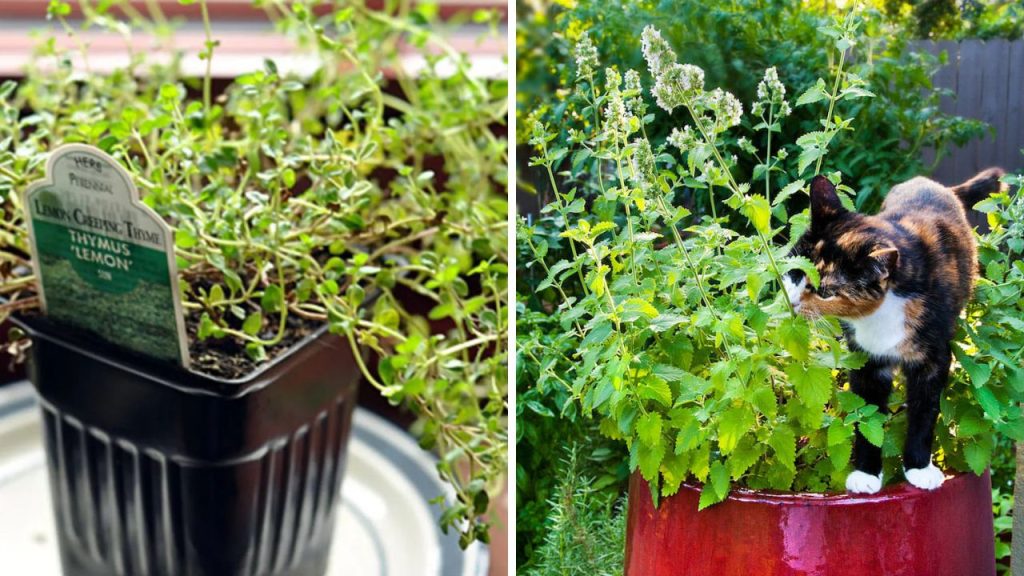Adding a beautiful garden along your fence can do wonders for your backyard, offering privacy, color, and texture to transform any outdoor space. Whether you’re looking for a rustic, wild, or low-maintenance design, there’s a border garden idea for every style and space. With a little creativity, you can create a garden that enhances your fence, making it not just a boundary, but a key feature in your landscaping. This guide will walk you through 19 inspiring border garden ideas to help you create the perfect outdoor sanctuary.
1. Rustic Cottage Garden Border

A rustic cottage garden is the epitome of charm and coziness, and it’s the perfect way to add a bit of country elegance to your backyard. Imagine a lush, overgrown garden full of wildflowers, climbing vines, and fragrant herbs — this is the essence of a rustic cottage garden border.
Start by planting climbing roses, lavender, or jasmine along your fence to create a dreamy, natural atmosphere. These plants not only offer vibrant blooms and lovely fragrances, but they’ll also help to soften the structure of your fence, giving the entire space a relaxed, welcoming feel. Consider adding a few herbs like thyme or mint that can grow freely and spill over, adding a touch of whimsy.
Layering different heights of plants is key to achieving the cottage garden look. Tall delphiniums or hollyhocks provide vertical interest, while lower-growing plants like daisies, echinacea, and daylilies offer a splash of color at the base. The mixture of textures, colors, and heights will create a visually appealing border that feels both intentional and relaxed.
2. Edible Garden Border
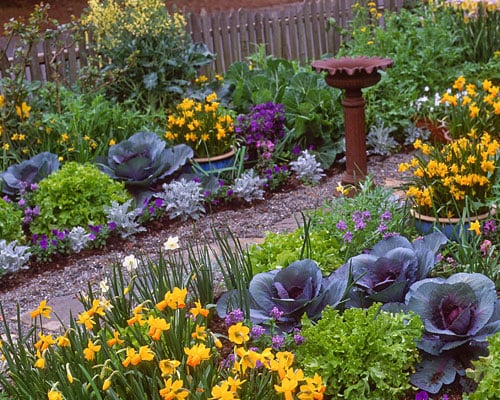
An edible garden border is a functional and beautiful way to take full advantage of the space along your fence. Imagine stepping outside to pick fresh herbs, vegetables, or fruits right from your own backyard. It’s an ideal way to make your garden work for you while adding a vibrant touch of life and color to your outdoor space.
Start with planting herbs such as basil, oregano, or parsley that thrive in the sunshine next to your fence. These fragrant plants not only provide delicious flavors for cooking but also add texture and green tones to your garden. If you’re looking for something more substantial, try vegetables like tomatoes, cucumbers, or peppers, which will grow well along the fence line. A few berry bushes, such as strawberries or raspberries, can also be an attractive, edible option for the lower part of the fence.
One of the great benefits of an edible garden border is that it can be easily customized depending on your space and sunlight. You can also combine edibles with flowers such as marigolds or sunflowers to create a colorful, inviting space. With a little care, your edible border will flourish and provide a bounty of homegrown goodness.
3. Succulent Fence Garden
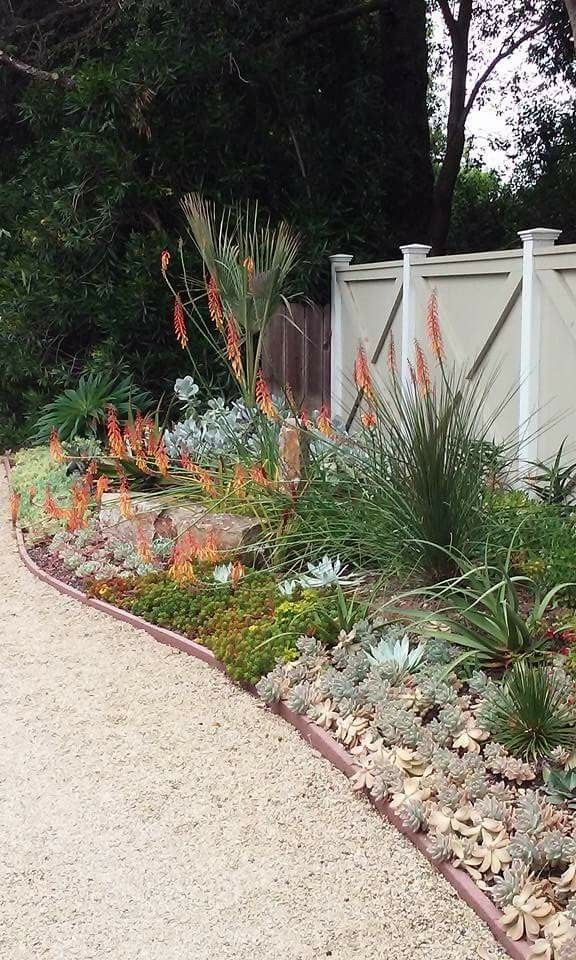
For those who prefer a low-maintenance garden that still offers visual impact, a succulent fence garden is the perfect choice. Succulents are hardy, drought-resistant, and come in a variety of colors and textures, making them an ideal option for borders along fences in sunny areas.
Planting succulents along your fence creates a modern, sleek look that’s both easy to maintain and visually striking. Consider varieties such as aloe vera, echeveria, or sedum, which can be planted in small clusters for maximum effect. These plants thrive in dry, well-draining soil, so they’re perfect for spots that don’t get a lot of rainfall. They can also tolerate the heat, making them ideal for warmer climates.
To enhance the visual appeal, mix different shapes, colors, and textures of succulents, from the spiky forms of agave to the round, soft leaves of jade plants. Adding some decorative gravel or pebbles at the base of the fence can provide a clean and modern contrast to the greenery. Succulents can be planted directly in the soil or in containers mounted along the fence for added versatility.
4. Vertical Garden with Planter Boxes
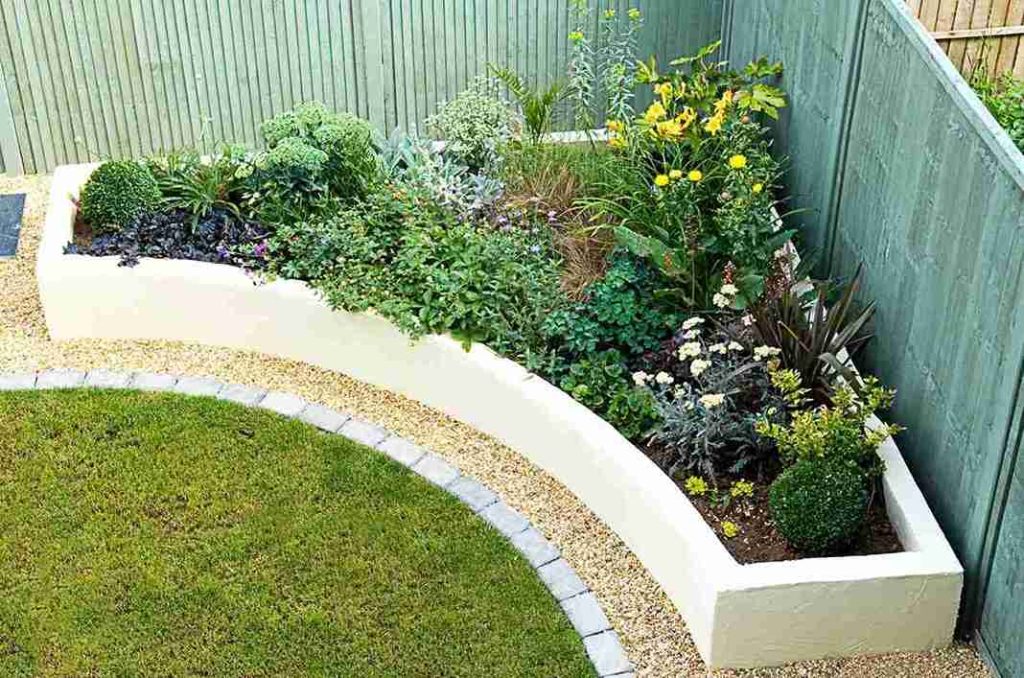
If you’re looking for a way to add more greenery without taking up too much space, a vertical garden with planter boxes is an excellent solution. This design makes use of vertical space, turning your fence into a multi-dimensional garden that’s both functional and beautiful.
Planter boxes can be easily mounted onto your fence, offering a space to grow a variety of plants, from flowers to vegetables or even small trees. Choose plants that thrive in containers, such as petunias, begonias, or herbs like rosemary and thyme. A mix of flowering plants and greenery will add color and texture, creating a border that feels lively and fresh.
One of the benefits of a vertical garden is that it helps keep the garden organized and easy to maintain. You won’t have to worry about weeds taking over, and the plants are easily accessible for watering and harvesting. Additionally, the height of the planters creates a natural layer of privacy, making your backyard feel more secluded and peaceful.
5. Wildflower Border Garden
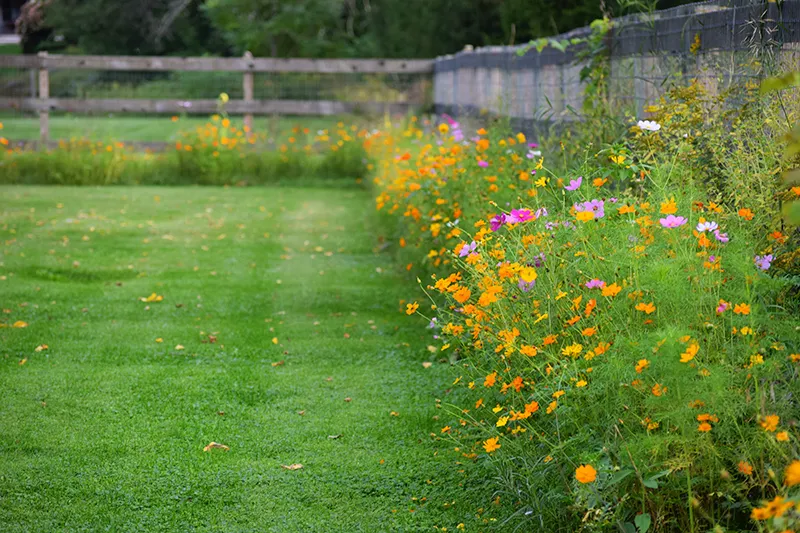
A wildflower border garden is perfect for anyone who loves a carefree, natural look. Wildflowers bring a sense of spontaneity and charm to any outdoor space, offering a splash of color that can transform even the most basic fence into a stunning focal point.
Planting native wildflowers along your fence is not only visually appealing but also great for the local ecosystem. Wildflowers attract pollinators like bees and butterflies, which are essential for healthy gardens and a thriving ecosystem. Depending on your region, you can plant species such as coneflowers, black-eyed Susans, and lupines for vibrant colors and textures.
A wildflower garden is low-maintenance and easy to establish. Simply scatter seeds along the base of your fence, and let nature take its course. The plants will often reseed themselves year after year, offering a colorful, ever-changing display. This type of garden is especially ideal for those looking to attract wildlife while minimizing the amount of time spent maintaining the space.
6. Tropical-Inspired Fence Border

If you’re looking to create an exotic oasis in your backyard, a tropical-inspired fence border is the way to go. This design brings lush greenery, vibrant colors, and a laid-back atmosphere to your outdoor space, creating the perfect retreat for those long summer days.
Start by incorporating tropical plants like palm trees, hibiscus, and ferns along your fence. These plants thrive in warm, sunny areas and will provide a burst of color with their large, vibrant flowers and foliage. The feathery fronds of palms and the striking blossoms of hibiscus plants will immediately transform your fence into a tropical paradise.
In addition to the plants, consider adding other tropical touches such as bamboo fencing, large planters, or even a small water feature to complete the look. Tropical gardens are all about creating a relaxing, resort-like atmosphere, so think about adding a few cozy seating areas or lounge chairs to make your outdoor space feel like an island retreat.
7. Zen Garden with Bamboo Border

Source
For a tranquil and minimalist look, a Zen garden with a bamboo border is the perfect choice. Inspired by Japanese garden design, this style focuses on simplicity, harmony, and natural beauty, creating a peaceful retreat in your own backyard.
Bamboo is an essential element in Zen gardens, known for its graceful, upright growth and calming presence. Planting bamboo along your fence creates a natural screen, adding privacy while maintaining a sense of openness and tranquility. Pair bamboo with smooth, polished stones or gravel, which can be spread out along the base of your fence to evoke the serene feel of a traditional Zen garden.
For the plants, opt for low-maintenance species such as ferns, moss, or Japanese maples. These plants not only add color and texture but also complement the peaceful atmosphere of your Zen garden. To complete the look, consider adding a few ornamental rocks, a water feature, or a small bench for reflection and relaxation.
8. Climbing Vines and Ivy
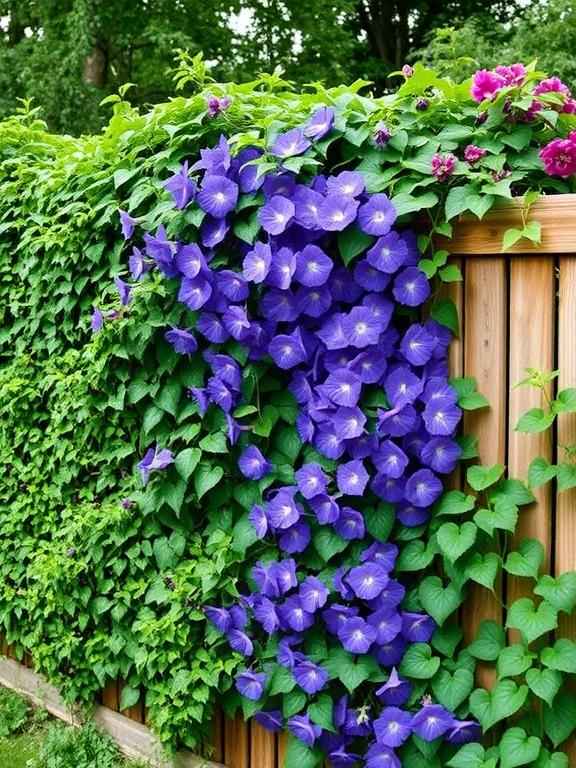
Source
If you’re looking to create a lush, green wall along your fence, climbing vines and ivy are the perfect solution. These plants are easy to grow and will quickly cover your fence with dense, vibrant greenery, adding privacy and beauty to your outdoor space.
Ivy, wisteria, clematis, or morning glories are all great choices for creating a climbing border along your fence. They’re easy to maintain and can grow quickly, offering a natural, organic look. Ivy, in particular, provides year-round greenery, while flowering vines like wisteria and clematis add stunning blooms in the spring and summer.
One of the great things about climbing vines is that they can adapt to different fence heights and types. You can train them to grow along the fence using trellises or simply let them sprawl naturally. Over time, the vines will create a living wall that provides shade, privacy, and a sense of enclosure in your outdoor space.
9. Flowering Shrub Border

Source
A flowering shrub border is a timeless and elegant way to enhance the area along your fence. Flowering shrubs add structure, color, and seasonal interest to your garden, creating a beautiful backdrop for your outdoor living space.
Popular choices for flowering shrubs include hydrangeas, lilacs, azaleas, and camellias. These plants offer a range of bloom colors, from soft pinks and purples to bold reds and whites. Planting a mix of varieties will ensure that your fence is adorned with flowers throughout the year, providing constant beauty and interest.
Flowering shrubs are also great for creating privacy, as they tend to grow dense and tall, creating a natural barrier between your yard and the outside world. They also require minimal maintenance once established, making them a practical choice for busy gardeners who still want to enjoy a colorful, fragrant garden border.
10. Shade-Loving Plants for North-Facing Fences

Source
For those with north-facing fences that don’t receive much sunlight, a shade-loving plant border is a must. Many beautiful plants thrive in low-light conditions, allowing you to create a lush, green garden even in the shadier corners of your yard.
Consider planting ferns, hostas, astilbes, or coral bells along your fence. These plants are perfect for adding texture, color, and life to shaded areas. Ferns offer delicate, feathery fronds that create a soft, natural look, while hostas provide large, bold leaves in various shades of green and blue. Astilbes, with their feathery blooms, can add a pop of color in the spring and summer months.
Shade-loving plants often thrive in moist, well-drained soil, so be sure to keep an eye on watering and avoid letting the area become too dry. Adding mulch can help retain moisture and keep the roots cool during hot weather. These plants will provide a beautiful, low-maintenance garden that thrives in the shade, adding beauty to your fence even in less-than-ideal sunlight conditions.
This completes the first section of your 19 border garden ideas, offering creative solutions for turning your fence into a stunning garden feature. Stay tuned for more inspiration in the next section!
11. Fairy Garden Border

Source
If you’re looking to add a touch of magic and whimsy to your backyard, a fairy garden border is the perfect way to infuse your space with charm and personality. Fairy gardens allow you to create a miniature world full of tiny houses, figurines, and delicate plants that will transport you to a magical realm.
Start by planting creeping thyme, moss, or lavender along the base of your fence, which will create the perfect setting for your fairy garden. These low-growing plants not only offer vibrant greenery but also produce a lovely fragrance that complements the magical atmosphere. To create the fairy garden effect, incorporate small fairy houses, whimsical statues, or tiny fairy figurines nestled amongst the plants.
A fairy garden can be customized to your taste, whether you prefer a natural woodland setting or a more whimsical, colorful approach. Add decorative stones, tiny bridges, or little pathways to guide the fairies through your garden. The fun part is that you can keep adding new elements over time, such as fairy lights, mini benches, or even a small pond. This garden border will captivate your imagination and bring a delightful sense of wonder to your backyard.
12. DIY Painted Fence Garden Border
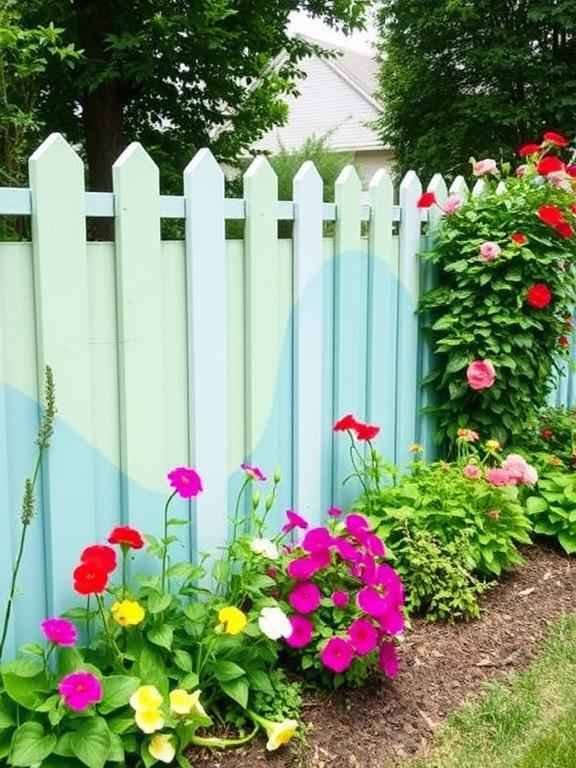
Source
If you want to add a creative and personal touch to your garden, consider incorporating a DIY painted fence border. A painted fence not only enhances the aesthetic of your garden but also allows you to express your personality and style.
Start by choosing a bold color for your fence — something that complements the plants you plan to grow along it. A fresh coat of paint on the fence can instantly transform an ordinary backyard into something extraordinary. For an extra layer of creativity, consider painting a mural or abstract design, or even creating a striped or ombré effect to add visual interest.
Pair your painted fence with plants that complement the color and style of the paint. Vibrant flowers like geraniums, petunias, or lantanas work well against a brightly painted fence, while a more muted fence color, such as sage green or soft gray, pairs nicely with lush greenery or delicate flowers like roses and lilies. A painted fence garden border can serve as the centerpiece of your outdoor space, drawing attention to your carefully selected plants and adding personality to your backyard.
13. Low Maintenance Gravel Border
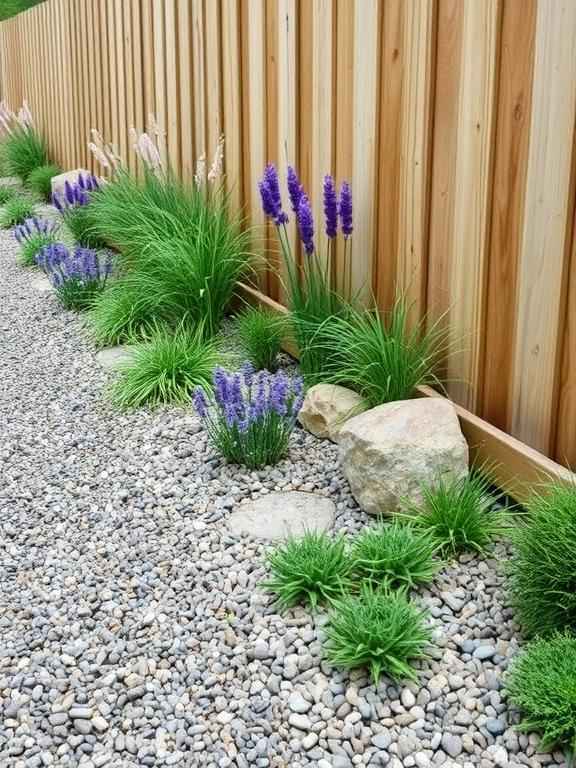
Source
For those looking for a garden that’s both simple and stunning, a low-maintenance gravel border is the perfect solution. This design requires minimal upkeep while still offering a clean and modern look that enhances your fence.
Gravel is an excellent choice for creating a sleek, low-maintenance border because it allows water to drain easily, preventing the growth of weeds. Simply line the base of your fence with a thick layer of decorative gravel, then choose plants that thrive in dry, well-drained soil. Drought-tolerant plants such as lavender, ornamental grasses, and sedum are ideal for this type of border.
You can also consider incorporating larger stones or rocks to add texture and dimension to the gravel area. By mixing in a variety of plant heights, from tall grasses to low-growing succulents, you’ll create an attractive contrast against the smooth gravel. This garden design is perfect for those who want to add natural beauty to their outdoor space without spending a lot of time on maintenance.
14. Classic Boxwood Hedge
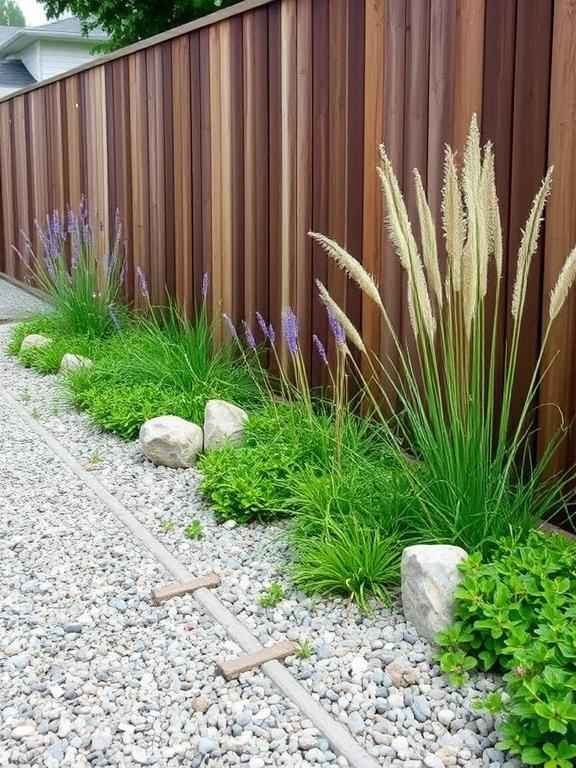
Source
For a timeless, polished look, a classic boxwood hedge is an excellent choice for your fence garden. Boxwoods are dense, evergreen shrubs that create a neat and structured border, offering year-round interest.
Planting a boxwood hedge along your fence provides a formal, symmetrical look that can add a sense of refinement and order to your yard. The dense foliage of boxwoods creates a natural privacy screen, blocking out unwanted views while still allowing light and air to flow through. These plants grow slowly but steadily, allowing you to shape them into neat hedges over time.
One of the great benefits of boxwoods is that they are incredibly versatile. They can be shaped into straight lines for a formal garden, or you can allow them to grow in a more natural, rounded form. A boxwood hedge pairs well with colorful flowers, such as roses or daffodils, which can bloom in front of the hedge for added color and texture. If you prefer a minimalistic, structured approach to your fence garden, a boxwood hedge is a fantastic option.
15. Rustic Wood Fence Garden
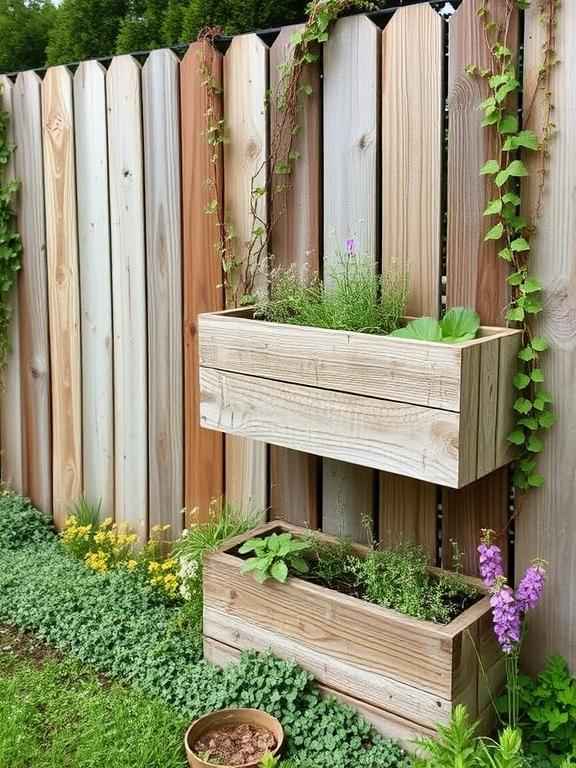
Source
If you have a wooden fence, why not embrace its natural charm by pairing it with a rustic wood fence garden? The combination of wood and greenery creates a warm, earthy vibe that complements a variety of garden styles.
To enhance the rustic look, plant creeping thyme, moss, or wildflowers at the base of your fence. These plants will spill over the edge of the wood, softening the harsh lines of the fence and blending seamlessly with the natural environment. You can also incorporate climbing vines like ivy, wisteria, or honeysuckle, which will crawl up the fence and create a lush, living wall.
For added texture, consider using weathered wooden planters or reclaimed wood to create raised garden beds along your fence. These can be filled with herbs, vegetables, or flowers, creating a practical and aesthetic border. The combination of wood and plants will evoke a sense of rustic simplicity and make your fence a stunning feature of your garden.
16. Colorful Flower Border
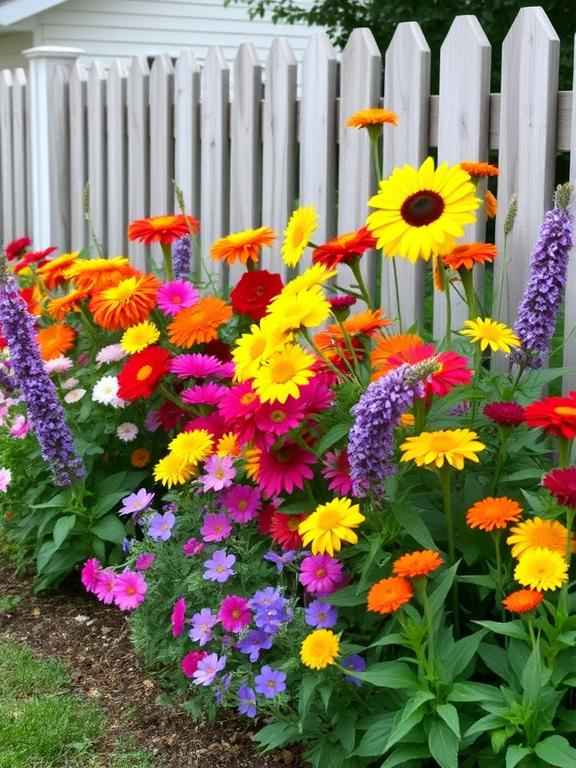
Source
If you’re looking to add vibrancy and life to your garden, a colorful flower border is the perfect option. A mix of bright, bold flowers will instantly transform any fence into a lively and welcoming feature of your backyard.
Plant a variety of flowers such as sunflowers, daisies, and marigolds along your fence to create a burst of color. Layering plants of different heights and colors will give the border a dynamic, multi-dimensional look. You can also experiment with color schemes — choose warm-toned flowers like reds, yellows, and oranges for a sunny, energetic look, or cool tones like purples and blues for a more serene, calming effect.
A flower border offers seasonal interest as well. As the flowers bloom and fade, the overall look of your fence garden will change, keeping the design fresh and exciting throughout the year. Add a few perennials alongside your annual flowers, such as coneflowers or lavender, for lasting beauty.
17. Privacy Garden with Tall Grasses
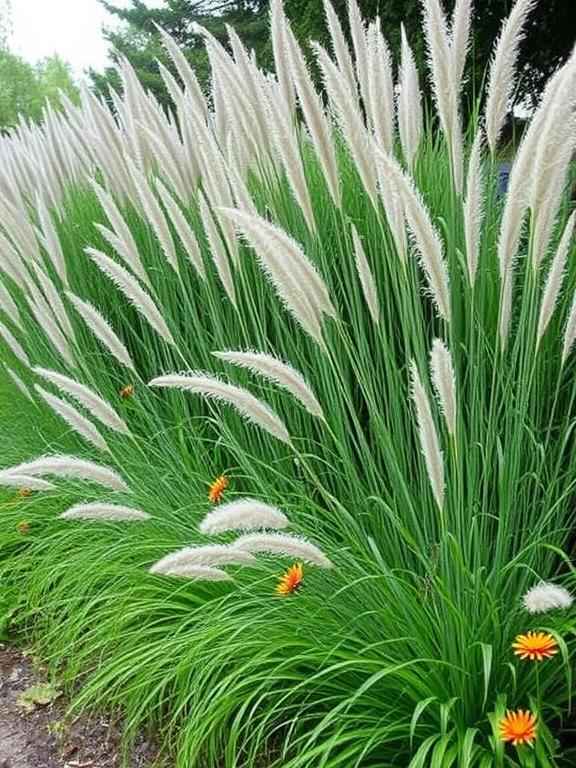
Source
If privacy is a concern, a garden made up of tall ornamental grasses is a wonderful solution. These grasses not only provide a natural screen but also add movement and texture to your fence border.
Grasses like pampas grass, miscanthus, or switchgrass can grow tall and dense, creating a soft, flowing barrier between your yard and the outside world. The tall, feathery plumes of these grasses add interest and create a soothing, natural effect, especially when they sway in the breeze. Tall grasses are perfect for providing privacy without sacrificing beauty, and they can even soften the look of a chain-link or wooden fence.
You can combine tall grasses with flowering plants or shrubs for added color and texture. Incorporating plants such as black-eyed Susans or asters will add vibrant hues to the border, while keeping the area private and serene. A privacy garden with tall grasses is perfect for creating a peaceful, secluded backyard retreat.
18. Perennial Border for Year-Round Interest
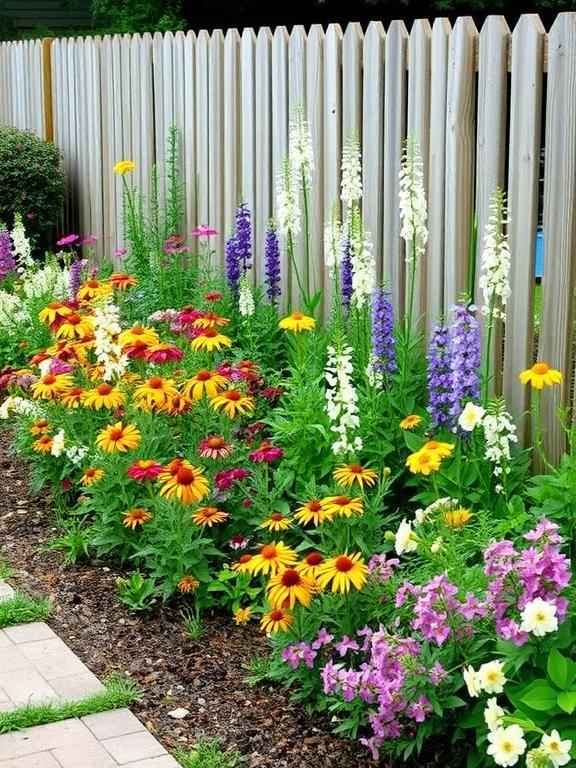
Source
A perennial border along your fence ensures that your garden looks beautiful all year long, with flowers that bloom in different seasons. Perennials are plants that come back year after year, offering long-lasting color and interest in your garden without the need for constant replanting.
Consider planting perennial flowers such as echinacea, black-eyed Susans, or daylilies along your fence. These plants bloom in the spring and summer, providing vibrant color and texture. For added visual interest, plant shrubs like spirea or lilacs, which bloom in the late spring and offer beautiful flowers and foliage.
One of the main benefits of a perennial border is that it’s relatively low-maintenance. Once established, perennials require little care beyond occasional pruning and watering. With a thoughtful mix of plants that bloom at different times, your fence garden will remain attractive throughout the year.
19. Cacti and Desert-Inspired Border

Source
If you’re drawn to the rugged beauty of desert landscapes, a cacti and desert-inspired border along your fence can create a unique and striking outdoor space. This design features drought-tolerant plants that thrive in hot, dry conditions, making it an ideal choice for arid climates or low-maintenance gardens.
Plant varieties of cacti such as prickly pear, agave, or yucca along your fence to create a bold and sculptural garden border. The architectural shapes of these plants, combined with their striking colors, make them a natural choice for a desert-inspired design. You can also include drought-tolerant succulents and ornamental grasses to add texture and variety.
For a more cohesive look, consider using gravel or sand at the base of your fence to complement the desert theme. Rocks or boulders can also be used to add dimension and create a more natural desert aesthetic. This low-maintenance border is perfect for those who appreciate the beauty of the desert and want a garden that thrives with minimal care.
Conclusion
Creating a border garden along your fence is an excellent way to enhance your backyard space and add visual interest. Whether you prefer the elegance of a flowering shrub hedge, the whimsy of a fairy garden, or the minimalist appeal of a Zen garden, there are endless possibilities to make your outdoor space unique and inviting.
By considering your personal style, climate, and maintenance preferences, you can choose the perfect border garden idea to complement your fence and transform your backyard into a beautiful retreat. Whether you’re aiming for a tropical oasis, a rustic cottage charm, or a low-maintenance, modern garden, there’s a fence border that will suit your needs and bring your vision to life. With just a little creativity and care, you can enjoy a stunning garden that adds beauty, privacy, and functionality to your outdoor space year-round.
